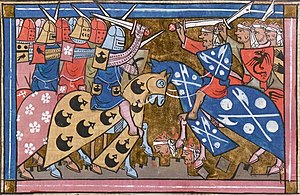The 1140s was a decade of the Julian Calendar which began on January 1, 1140, and ended on December 31, 1149.
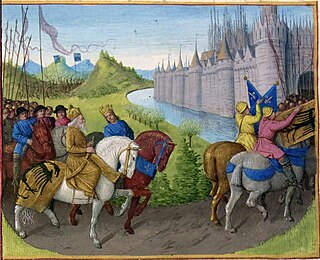
Year 1147 (MCXLVII) was a common year starting on Wednesday of the Julian calendar.
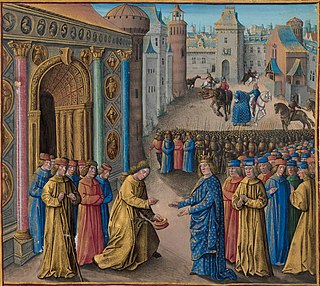
Year 1148 (MCXLVIII) was a leap year starting on Thursday of the Julian calendar.

The First Crusade (1096–1099) was the first of a series of religious wars, or Crusades, initiated, supported and at times directed by the Latin Church in the medieval period. The objective was the recovery of the Holy Land from Islamic rule. While Jerusalem had been under Muslim rule for hundreds of years, by the 11th century the Seljuk takeover of the region threatened local Christian populations, pilgrimages from the West, and the Byzantine Empire itself. The earliest initiative for the First Crusade began in 1095 when Byzantine emperor Alexios I Komnenos requested military support from the Council of Piacenza in the empire's conflict with the Seljuk-led Turks. This was followed later in the year by the Council of Clermont, during which Pope Urban II supported the Byzantine request for military assistance and also urged faithful Christians to undertake an armed pilgrimage to Jerusalem.
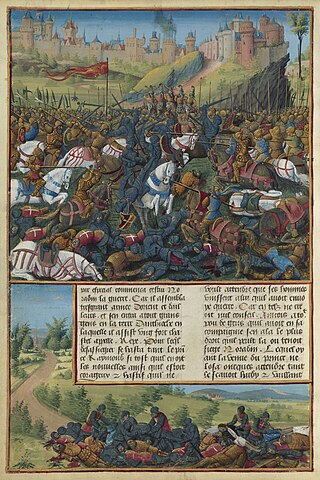
The Second Crusade (1147–1150) was the second major crusade launched from Europe. The Second Crusade was started in response to the fall of the County of Edessa in 1144 to the forces of Zengi. The county had been founded during the First Crusade (1096–1099) by King Baldwin I of Jerusalem in 1098. While it was the first Crusader state to be founded, it was also the first to fall.

Baldwin I was the first count of Edessa from 1098 to 1100 and king of Jerusalem from 1100 to his death in 1118. He was the youngest son of Eustace II, Count of Boulogne, and Ida of Lorraine and married a Norman noblewoman, Godehilde of Tosny. He received the County of Verdun in 1096, but he soon joined the crusader army of his brother Godfrey of Bouillon and became one of the most successful commanders of the First Crusade.

The Battle of Manzikert or Malazgirt was fought between the Byzantine Empire and the Seljuk Empire on 26 August 1071 near Manzikert, theme of Iberia. The decisive defeat of the Byzantine army and the capture of the Emperor Romanos IV Diogenes played an important role in undermining Byzantine authority in Anatolia and Armenia, and allowed for the gradual Turkification of Anatolia. Many Turks, travelling westward during the 11th century, saw the victory at Manzikert as an entrance to Asia Minor.
The Battle of Myriokephalon was a battle between the Byzantine Empire and the Seljuk Turks in Phrygia in the mountains west of Iconium (Konya) in southwestern Turkey on 17 September 1176. The battle was a strategic reverse for the Byzantine forces, who were ambushed when moving through a mountain pass.
Kilij Arslan ibn Suleiman (1079–1107) was the Seljuq Sultan of Rum from 1092 until his death in 1107. He ruled the Sultanate during the time of the First Crusade and thus faced the earliest attacks from Christian forces. He also re-established the Sultanate of Rum after the death of Malik Shah I of the Seljuk Empire and defeated the Crusaders in three battles during the Crusade of 1101. Kilij Arslan was the first Muslim and Turkish commander to fight against the Crusaders, commanding his horse archers as a teenager.

The Battle of Dorylaeum took place during the First Crusade on 1 July 1097 between the crusader forces and the Seljuk Turks, near the city of Dorylaeum in Anatolia. Though the Turkish forces of Kilij Arslan nearly destroyed the Crusader contingent of Bohemond, other Crusaders arrived just in time to reverse the course of the battle.

The Crusade of 1101 was a minor crusade of three separate movements, organized in 1100 and 1101 in the successful aftermath of the First Crusade. It is also called the Crusade of the Faint-Hearted due to the number of participants who joined this crusade after having turned back from the First Crusade.
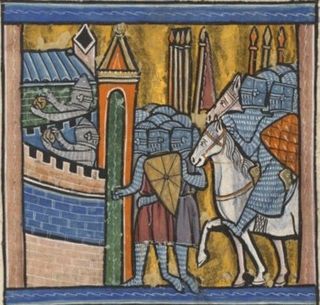
The siege of Nicaea was the first major battle of the First Crusade, taking place from 14 May to 19 June 1097. The city was under the control of the Seljuk Turks who opted to surrender to the Byzantines in fear of the crusaders breaking into the city. The siege was followed by the Battle of Dorylaeum and the Siege of Antioch, all taking place in modern Turkey.

The siege of Damascus took place between 24 and 28 July 1148, during the Second Crusade. It ended in a crusader defeat and led to the disintegration of the crusade. The two main Christian forces that marched to the Holy Land in response to Pope Eugene III and Bernard of Clairvaux's call for the Second Crusade were led by Kings Louis VII of France and Conrad III of Germany. Both faced disastrous marches across Anatolia in the months that followed, with most of their armies being destroyed. The original focus of the crusade was Edessa (Urfa), but in Jerusalem, the preferred target of King Baldwin III and the Knights Templar was Damascus. At the Council of Acre, magnates from France, Germany, and the Kingdom of Jerusalem decided to divert the crusade to Damascus.

The Byzantine–Seljuk wars were a series of conflicts in the Middle Ages between the Byzantine Empire and the Seljuk Empire. They shifted the balance of power in Asia Minor and Syria from the Byzantines to the Seljuk dynasty. Riding from the steppes of Central Asia, the Seljuks replicated tactics practiced by the Huns hundreds of years earlier against a similar Roman opponent but now combining it with new-found Islamic zeal. In many ways, the Seljuk resumed the conquests of the Muslims in the Byzantine–Arab Wars initiated by the Rashidun, Umayyad and Abbasid Caliphates in the Levant, North Africa and Asia Minor.

The Council of Acre met at Palmarea, near Acre, a major city of the crusader Kingdom of Jerusalem, on 24 June 1148. The Haute Cour of Jerusalem met with recently arrived crusaders from Europe, to decide on the best target for the crusade. The Second Crusade had been called after the fall of Edessa to Zengi in 1144. In 1147, armies led by Conrad III of Germany and Louis VII of France began their separate journeys to the east. Conrad arrived at Acre in April 1148, and Louis marched south from Antioch.

The Battle of Mount Cadmus took place near Laodicea, at Honaz, on January 6, 1148, during the Second Crusade. The French crusader army, led by Louis VII of France, was defeated by the Seljuks of Rum.
The Battle of the Meander took place in December 1147, during the Second Crusade. The French crusader army, led by Louis VII of France, successfully fended off an ambush by the Seljuks of Rum at the Meander River.
The Battle of Ephesus took place on 24 December 1147, during the Second Crusade. The French crusader army, led by Louis VII of France, successfully fended off an ambush by the Seljuks of Rum led by Sultan Mesud I just outside the town of Ephesus.
The Battle of Constantinople in 1147 was a large-scale clash between the forces of the Byzantine Empire and the German crusaders of the Second Crusade, led by Conrad III of Germany, fought on the outskirts of the Byzantine capital, Constantinople. The Byzantine emperor Manuel I Komnenos was deeply concerned by the presence of a large and unruly army in the immediate vicinity of his capital and of the unfriendly attitude of its leaders. A similarly sized French crusader army was also approaching Constantinople, and the possibility of the two armies combining at the city was viewed with great alarm by Manuel. Following earlier armed clashes with the crusaders, and perceived insults from Conrad, Manuel arrayed some of his forces outside the walls of Constantinople. Part of the German army then attacked and was defeated; according to British historian Michael Angold, they suffered heavy losses. Following this defeat the crusaders agreed to be quickly ferried across the Bosporus to Asia Minor.
Yağısıyan, also known as Yaghi-Siyan was a Seljuk Turkoman commander and governor of Antioch in the 11th century. Although little is known about his personal life he was an important figure of the First Crusade.
